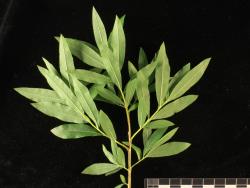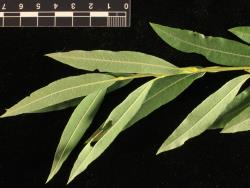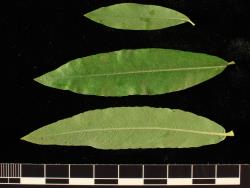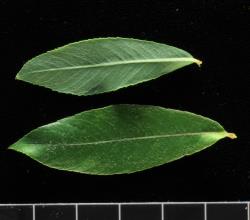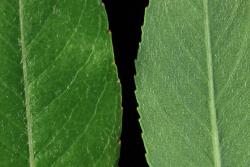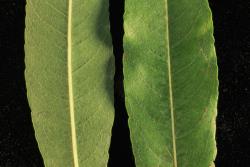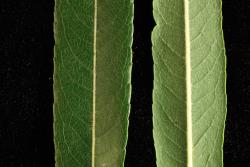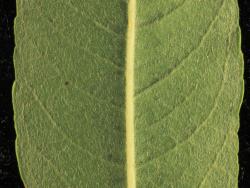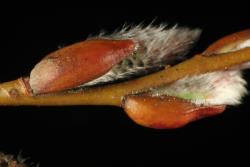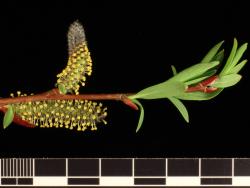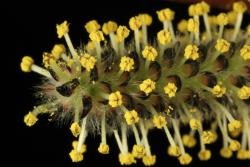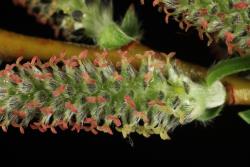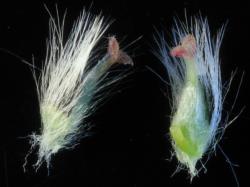Erect multi-stemmed shrub. Current year's branchlets glabrous to sparsely tomentose. Year-old branchlets glabrous to sparsely tomentose, 1.5–3.0 mm diameter. Bud scales 7 mm long, 3.5 mm wide, with strong lateral angles, spooned at the apex, glabrous or moderately densely hairy. Leaves alternate. Stipule 2.5 mm long, asymmetrically ovate, entire, somewhat persistent. Petiole 5–11 mm long, sparsely tomentose, glands absent, base of petiole not enlarged. Emerging leaves with moderately densely short-silky hairs on both sides. Proximal leaves serrate. Leaf lamina 75–120 mm long, 15 mm wide, length to width ratio 6.8–10.0:1, very narrowly ovate to very narrowly oblong with parallel margins, not falcate; base cuneate; apex acute to narrowly acute; leaf galls absent; margins slightly serrate, plane to very slightly revolute; upper lamina surface plane, moderately glossy, glabrous, stomata absent; lower lamina surface midvein raised, not glaucous, sparsely short-silky hairy, hairs a mixture of silver and brown. Catkins female, emerging simultaneously with leaves. Flowering branch 35–55 mm long with 6 cataphylls below catkin. Male catkin 28–30 mm long, 6–7 mm diameter; catkin rachis not visible between flowers. Female catkin 30–55 mm long, 9–29 mm diameter; catkin rachis visible or not between flowers. Flower bract either of S. viminalis type: 3.0 mm long, 1.1 mm wide, brown; apex acute or bitten, long silky hairs on all surfaces, or of S. purpurea type: 1.5 mm long, 0.7 mm wide, bicoloured and black at the apex, red or hyaline at the base; apex rounded, long-silky hairs on all surfaces; female bracts persistent. Male nectary 1, 0.4 mm long, 0.15 mm wide. Stamens 2, filaments free, hairs absent; anthers 0.75 mm long, yellow but slightly tinted red. Female catkin 25–35 mm long, 3.5 mm diameter; catkin rachis not visible between flowers. Nectary 1, 0.9 mm long, 0.4 mm wide; ovary 2.4 mm long, sparsely long-silky hairy, exceeding flower bract; stipe 0.6–0.8 mm long, style base 0.5 mm long, style arms 0.2–0.8 mm long, variably bilobed.
Leaves and stems are similar to those of Salix purpurea, but the leaves are never opposite as they are in S. purpurea. Stipules are somewhat persistent; the young leaves are moderately densely hairy on the underside with appressed short, straight hairs; and the upper leaf surface is sparsely hairy, becoming glabrous. Mature leaves become almost glabrous. Brown hairs may be mixed with silver hairs. Flower bud scales are variable. As described by Meikle (1984, p. 74), they are usually like those of S. purpurea (bicoloured and obtuse), and less often they are like those of S. viminalis (uniformly green, turning brown, with an acute apex). Style arms are medium in length, not as long as in S. viminalis, and are variably and asymmetrically lobed so that in some cases one style arm is long and lobed and the other short and toothed. The ovary is stalked, unlike that of S. purpurea. Stamens have 2 free filaments (variably united according to Meikle 1984, p. 74).
In New Zealand there are also plants, both in cultivation and in the wild, of a similar hybrid, dealt with in Meikle (1984) under the name Salix ×forbyana Sm., and according to Meikle likely to be the triple hybrid S. cinerea × S. purpurea × S. viminalis. Meikle (1984, p. 80) comments that "S. ×forbyana may possibly be nothing more than a variant of the well-known S. ×rubra Huds. There is, however, something distinctive in the leaf shape, and in the indumentum of the youngest leaves, which may be attributable to the presence of S. cinerea." This accords with New Zealand plants, whose leaves are wider than those of S. ×rubra, up to 35 mm wide rather than 15 mm wide. These plants vary in features such as style base length and stipe length.
In cultivation in Palmerston North, as PN305.
First collection: CHR 232366, A. J. Healy 65/39 & B. E. V. Parham, 11 October 1965, Waimakariri River stopbank.
First publication: This publication.
Flowering: Late August–mid October.
Unknown.



